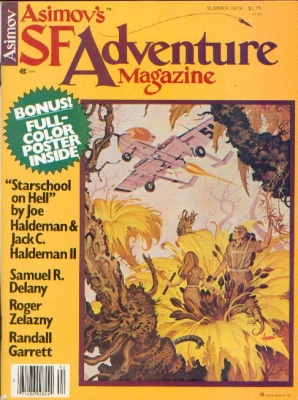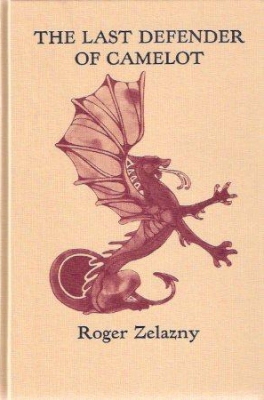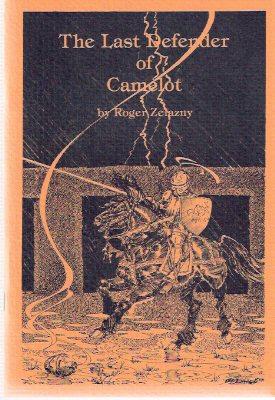The Golden Age of Science Fiction: “The Last Defender of Camelot,” by Roger Zelazny
The Balrog Award, often referred to as the coveted Balrog Award, was created by Jonathan Bacon and first conceived in issue 10/11 of his Fantasy Crossroads fanzine in 1977 and actually announced in the final issue, where he also proposed the Smitty Awards for fantasy poetry. The awards were presented for the first time at Fool-Con II at the Johnson County Community College in Overland Park, Kansas on April 1, 1979. The awards were never taken particularly seriously, even by those who won the award. The final awards were presented in 1985. Presented variously for “Short Fiction” and “Short Story,” this award was given out each year the Balrogs were presented.
Roger Zelazny’s “The Last Defender of Camelot” places an eternal Sir Lancelot in the modern era, dealing with such enemies as street muggers. Unsure of why he has a long life, he wanders the globe aimlessly, adapting to the new world while remembering the glory that was Camelot and searching for the Holy Grail. A (possibly) chance meeting with a fortune teller who turns out to be an equally long-lived Morgana LeFay informs him that he will never succeed in finding the Holy Grail, but instead the reason for his long life is that Merlin is about to awaken from his millennia long sleep and will need Lancelot to provide him with a guide to this future world.
Zelazny does an excellent job when it comes to playing around with the tropes in the story, fully cognizant of the various versions of the stories surrounding his three Arthurian characters. Lancelot holds himself responsible for betraying Arthur with Guinevere. Morgan LeFay is surprised to see him, having expected him to be long buried in Joyous Gard. She warns Lancelot about the dangers of bringing Merlin into the twentieth century, giving the sorcerer credit for being an idealist, but realizing that idealism doesn’t always mesh well with pragmatism or changes in society. In a few words, Zelazny is able to shift the reader’s image of Merlin so when the wizard awakens, he isn’t quite the antagonist of the story, but he also isn’t a particularly sympathetic creature. Merlin realizes that Lancelot isn’t going to be the champion he expected and tries to find ways to sidetrack him from becoming an enemy.
The effectiveness of the story comes, in part, because each reader will bring their own understanding of the Arthurian myth to their interpretation, whether they know the characters from Malory’s Le Morte d’Arthur or John Boorman’s Excalibur or T.H. White’s The Once and Future King or Alan Jay Lerner and Frederick Loewe’s Camelot. The relationships in each of those versions differ, which means that each reader will approach the story with a different understanding of the dynamic between Morgana, Merlin, and Lancelot. This also means that the eventual climax of the story between Lancelot and Merlin may come about as either a comeuppance for one, or both, of the characters or the sort of betrayal which happened so often in the Arthurian legends.
Based on this category, the Balrogs were not given out by calendar year since one of the stories was published in 1980 (although it would have been on the newsstands in December 1979). Reprints were also apparently eligible. Zelazny’s story beat out Robert A. Heinlein’s 1959 story “’All You Zombies—’,” which was reprinted in 1979 in two books and a magazine as well as “The Button Molder,” by Fritz Leiber, “Dreams of the Dreamer,” by Joseph Hammond, “The Dreamstone,” by C. J. Cherryh, “The Fane of the Grey Rose,” by Charles de Lint, “Northern Chess,” by Tanith Lee, “The Ocean of Souls,” by Adrian Cole, “Sandkings,” by George R. R. Martin, “Spareen Among the Tartars,” by Susan C. Petrey, “The Well at the Half-Calf,” by John Tibbetts, and the 1980 dated “Vision,” by Ben Bova, which would have been on newsstands in December 1979.
 Steven H Silver is a sixteen-time Hugo Award nominee and was the publisher of the Hugo-nominated fanzine Argentus as well as the editor and publisher of ISFiC Press for 8 years. He has also edited books for DAW, NESFA Press, and ZNB. He began publishing short fiction in 2008 and his most recently published story is “Webinar: Web Sites” in The Tangled Web. His most recent anthology, Alternate Peace was published in June. Steven has chaired the first Midwest Construction, Windycon three times, and the SFWA Nebula Conference 6 times, as well as serving as the Event Coordinator for SFWA. He was programming chair for Chicon 2000 and Vice Chair of Chicon 7.
Steven H Silver is a sixteen-time Hugo Award nominee and was the publisher of the Hugo-nominated fanzine Argentus as well as the editor and publisher of ISFiC Press for 8 years. He has also edited books for DAW, NESFA Press, and ZNB. He began publishing short fiction in 2008 and his most recently published story is “Webinar: Web Sites” in The Tangled Web. His most recent anthology, Alternate Peace was published in June. Steven has chaired the first Midwest Construction, Windycon three times, and the SFWA Nebula Conference 6 times, as well as serving as the Event Coordinator for SFWA. He was programming chair for Chicon 2000 and Vice Chair of Chicon 7.



If the Balrog wasn’t previously “often” referred to as the “coveted Balrog award”, you are trying to make sure that description will be correct in the future, right, Steven? 🙂
Well, every time I’ve mentioned the award to winner Phyllis Eisenstein, she always responds, “You did refer to it as ‘the coveted Balrog Award,’ didn’t you?” So who am I to argue with someone who actually has one.
And, from Fancyclopedia, where the entry is actually for “Coveted Balrog Award:” “The (coveted) Balrog Award was presented by the International Fantasy Gamers Society at Foolcon from 1979 to 1982 and elsewhere from 1983 to 1985 to the best in a variety of predominantly fantasy categories. The award never was taken very seriously — probably because they gave out so many awards with a limited set of non-mainstream voters (and let’s not mention that naming an award after an evil demon is a bit odd) — and by tradition it is referred to as the ‘Coveted Balrog Award’.” http://fancyclopedia.org/coveted-balrog-award
“The Last Defender of Camelot” was also adapted by George R. R. Martin into an episode of The Twilight Zone in 1986. I’ve never seen it but I heard Martin in an interview comment that he was so embarrassed at the quality of the episode that he was fearful when Zelazny saw it. Don’t remember Zelazny’s actual reaction to it.
Nice treatment of one of my favorite later-Zelazny stories. Nice images, too, although my favorite cover is still the image Carl Lundgren created for the 1st Pocket Books addition.